An Energy-Harvesting System Using MPPT at Shock Absorber for Electric Vehicles
Abstract
1. Introduction
2. Linear Electromagnetic Generator
3. Active Power Converter for Energy-Harvesting Systems
3.1. Diode Rectifier of the DC Link Capacitance Design
3.2. Synchronous Buck Converter Design Specifications
3.3. P&O MPPT (Perturb and Observe Maximum Power Point Tracking) Algorithm
- (1)
- The DC link voltage is compared with the battery voltage, and if the DC link voltage is less than the battery voltage, the buck converter does not operate.
- (2)
- Total power is calculated using the sampled DC link voltage and current.
- (3)
- The amount of change in the output is calculated through 50 control loops.
- (4)
- According to the overall output change, the current reference command value is applied to calculate the amount of current change required to determine imppt.
- (5)
- The steps are repeated while operating with the calculated current reference:
4. Energy-Harvesting Generators and Power Converter Prototype
5. Results
6. Conclusions
Author Contributions
Funding
Institutional Review Board Statement
Informed Consent Statement
Data Availability Statement
Acknowledgments
Conflicts of Interest
References
- Paolo, L.; Vincenzo, C.; Aldo, C. Economic and environmental sustainability of Dynamic Wireless Power Transfer for electric vehicles supporting reduction of local air pollutant emissions. Renew. Sustain. Energy Rev. 2021, 138, 110537. [Google Scholar]
- Zhang, R.; Wang, X.; John, S. A Comprehensive Review of the Techniques on Regenerative Shock Absorber Systems. Energies 2018, 11, 1167. [Google Scholar] [CrossRef]
- Pornrawee, T.; Sontipee, A.; Pitak, L.; Raj, D. Thermomechanical Effects on Electrical Energy Harvested from Laminated Piezoelectric Devices. Crystals 2021, 11, 141. [Google Scholar]
- Hamid, J.; Sheeba, R.; Sofiya, S. Energy Harvesting through Regenerative Braking using Hybrid Storage System in Electric Vehicles. In Proceedings of the IEEE International Conference on Intelligent Techniques in Control, Optimization and Signal Processing (INCOS), Tamilnadu, India, 11–13 April 2019. [Google Scholar]
- Aliakbari, A.; Vahidinasab, V. Optimal Charging Scheduling of Solar Plugin Hybrid Electric Vehicles Considering On-the-Road Solar Energy Harvesting. In Proceedings of the 2020 Smart Grid Conference (SGC), Kashan, Iran, 16–17 December 2020. [Google Scholar]
- Zou, J.; Guo, X.; Xu, L.; Tan, G.; Zhang, C.; Zhang, J. Design, Modeling, and Analysis of a Novel Hydraulic Energy-Regenerative Shock Absorber for Vehicle Suspension. Shock. Vib. 2017, 3186584. [Google Scholar] [CrossRef]
- Abdelkareem, M.A.A.; Xu, L.; Ali, M.K.A.; Elagouz, A.; Mi, J.; Guo, S.; Liu, Y.; Zuo, L. Vibration energy harvesting in automotive suspension system: A detailed review. Appl. Energy 2018, 229, 672–699. [Google Scholar] [CrossRef]
- Dibin, Z.; Michael, J.-T.; Stephen, P.-B. Strategies for increasing the operating frequency range of vibration energy harvesters: A review. Meas. Sci. Technol. 2009, 21, 1–29. [Google Scholar]
- Zuo, L.; Zhang, P.S. Energy Harvesting, Ride Comfort, and Road Handling of Regenerative Vehicle Suspensions. J. Vib. Acoust Trans. ASME 2013, 135, 1–8. [Google Scholar] [CrossRef]
- Xiudong, T.; Teng, L.; Zuo, L. Design and Optimization of a Tubular Linear Electromagnetic Vibration Energy Harvester. IEEE/ASME Trans. 2014, 19, 615–622. [Google Scholar]
- Zuo, L.; Brian, S.; Jurgen, S.; Yu, Z. Design and characterization of an electromagnetic energy harvester for vehicle suspensions. Smart Mater. Struct. 2010, 19, 10. [Google Scholar] [CrossRef]
- Costanzo, L.; Lin, T.; Lin, W.; Schiavo, A.L.; Vitelli, M.; Zuo, L. Power Electronic Interface with an Adaptive MPPT Technique for Train Suspension Energy Harvesters. IEEE Trans. Ind. Electron. 2020, 1. [Google Scholar] [CrossRef]
- Carandell, M.; Toma, D.M.; Carbonell, M.; del Rio, J.; Gasulla, M. Design and Testing of a Kinetic Energy Harvester Embedded Into an Oceanic Drifter. IEEE Sens. J. 2020, 20, 13930–13939. [Google Scholar] [CrossRef]
- Tse, K.H.K.; Chung, H.S.-H. MPPT for Electromagnetic Energy Harvesters Having Nonnegligible Output Reactance Operating Under Slow-Varying Conditions. IEEE Trans. Power Electron. 2020, 35, 7110–7122. [Google Scholar] [CrossRef]
- Costanzo, L.; Schiavo, A.L.; Vitelli, M. Design Guidelines for the Perturb and Observe Technique for Electromagnetic Vibration Energy Harvesters Feeding Bridge Rectifiers. IEEE Trans. Ind. 2019, 55, 5089–5098. [Google Scholar] [CrossRef]
- Arroyo, E.; Badel, A.; Formosa, F.; Wu, Y.; Qiu, J. Comparison of electromagnetic and piezoelectric vibration energy harvesters: Model and expriments. Sens. Actuators A Phys. 2012, 183, 148–156. [Google Scholar] [CrossRef]
- Roundy, S.; Leland, E.S.; Baker, J.; Carleton, E.; Reilly, E.; Lai, E.; Otis, B.; Reilly, E.; Rabaey, J.M.; Wright, P.K.; et al. Improving power output for vibration-based energy scavengers. Pervasive Comput. IEEE 2005, 4, 28–36. [Google Scholar] [CrossRef]
- Sultoni, A.I.; Sutantra, I.N.; Pramono, A.S. Modeling, Prototyping and Testing of Regenerative Electromagnetic Shock Absorber. Appl. Mech. Mater. 2014, 493, 395–400. [Google Scholar] [CrossRef]
- Gysen, B.L.J.; Van Der Sande, T.P.J.; Paulides, J.J.H.; Lomonova, E.A. Efficiency of a Regenerative Direct-Drive Electromagnetic Active Suspension. IEEE Trans. Veh. Technol. 2011, 60, 1384–1393. [Google Scholar] [CrossRef]
- Li, Z.; Zuo, L.; Luhrs, G.; Lin, L.; Qin, Y.-X. Design, Modeling, and Road Tests of Electromagnetic Energy-Harvesting Shock Absorbers. In Proceedings of the ASME 2012 5th Annual Dynamic Systems Control Conference Joint with JSME 2012 11th Motion and Vibration Conference, Fort Lauderdale, FL, USA, 17–19 October 2012; Volume 3, pp. 675–684. [Google Scholar]
- Zhang, Z.; Zhang, X.; Chen, W.; Rasim, Y.; Salman, W.; Pan, H.; Yuan, Y.; Wang, C. A high-efficiency energy regenerative shock absorber using supercapacitors for renewable energy applications in range extended electric vehicle. Appl. Energy 2016, 178, 177–188. [Google Scholar] [CrossRef]
- Wang, J.; Howe, D. Tubular modular permanent-magnet machines equipped with quasi-Halbach magnetized magnets-part I: Magnetic field distribution, EMF, and thrust force. IEEE Trans. Magn. 2003, 481–484. [Google Scholar]
- Cho, S.J.; Kim, J.H. A Study on Optimal Design for Linear Electromagnetic Generator of Electricity Sensor System using Vibration Energy Harvesting. J. Korean Soc. Manuf. Process Eng. 2017, 16, 7–15. [Google Scholar] [CrossRef]
- Duong, M.T.; Chun, Y.D.; Han, P.W.; Park, B.G.; Bang, D.J.; Lee, J.K. Design of an Electromagnetic Energy Harvesting System Applied to Shock Absorber in Sport Utility Vehicle: Part I. Single Permanent Magnet Layer Coreless Type. J. Magn. 2017, 22, 435–442. [Google Scholar] [CrossRef][Green Version]
- Goldner, R.B.; Zerigina, P. Electromagnetic Linear Generator and Shock Absorber. U.S. Patent 6952060B2, 2005. [Google Scholar]
- Moon, S.R.; Lai, J.S.; Park, B.G.; Lee, J.Y.; Koo, D.H. Design and Control of Battery Charger for Portable Human Powered Generator. In Proceedings of the 2014 IEEE Applied Power Electronics Conference and Exposition, Fort Worth, TX, USA, 16–20 March 2014; pp. 1590–1597. [Google Scholar]
- Zhuochao, S.; Liter, S. A novel ripple controlled modulation for high efficiency DC-DC converters. In Proceedings of the 2011 International Symposium on Integrated Circuits, Singapore, 12–14 December 2011; pp. 238–241. [Google Scholar]
- Sera, D.; Teodorescu, R.; Hantschel, J.; Knoll, M. Optimized maximum power point tracker for fast-changing environmental conditions. IEEE Trans. Ind. Electron. 2008, 55, 2629–2637. [Google Scholar] [CrossRef]
- Hohm, D.; Ropp, M. Comparative study of maximum power point tracking algorithms using an experimental, programmable, maximum power point tracking test. In Proceedings of the 2000 IEEE Photovoltaic Specialists Conference, Anchorage, AK, USA, 15–22 September 2000; pp. 1699–1702. [Google Scholar]
- Femia, N.; Petrone, G.; Spagnuolo, G.; Vitelli, M. Perturb and Observe MPPT technique robustness improved. In Proceedings of the IEEE International Symposium on Industrial Electronics, Ajaccio, France, 4–7 May 2004; Volume 2, pp. 845–850. [Google Scholar]
- Sera, D.; Kerekes, T.; Teodorescu, R.; Blaabjerg, F. Improved MPPT method for rapidly changing environmental conditions. In Proceedings of the IEEE International Symposium on Industrial Electronics, Montreal, QC, Canada, 9–13 July 2006; Volume 2, pp. 1420–1425. [Google Scholar]
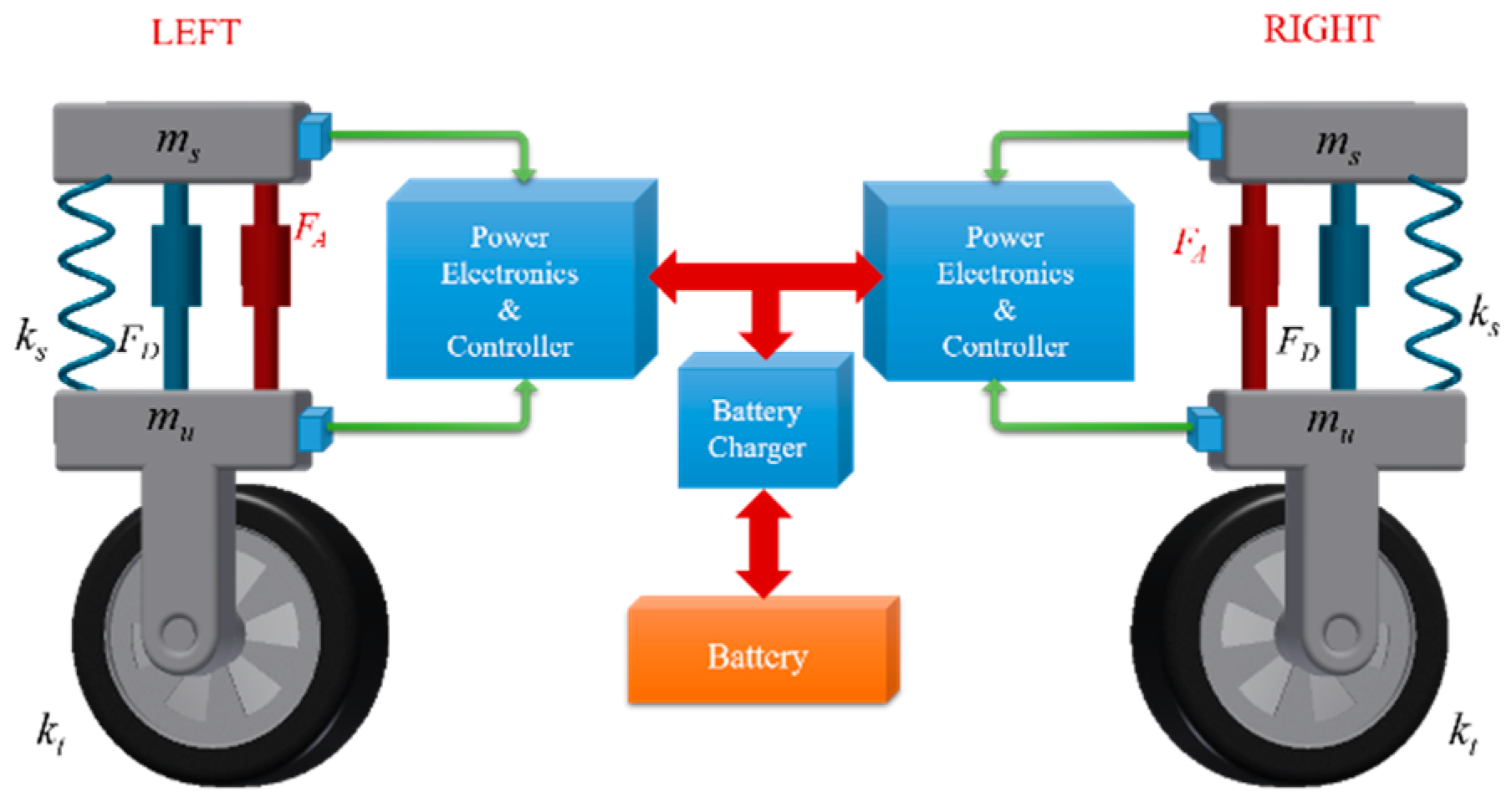


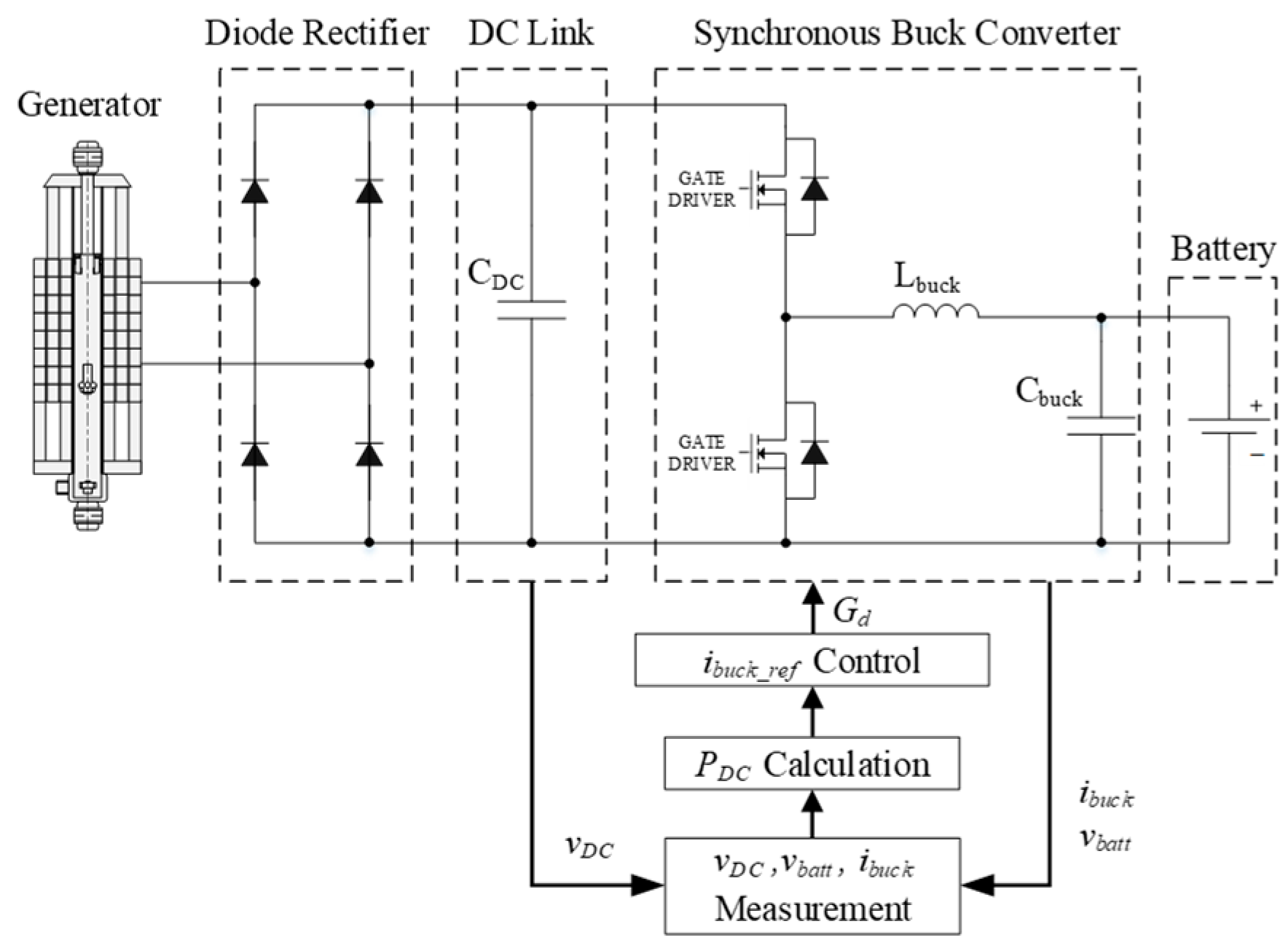

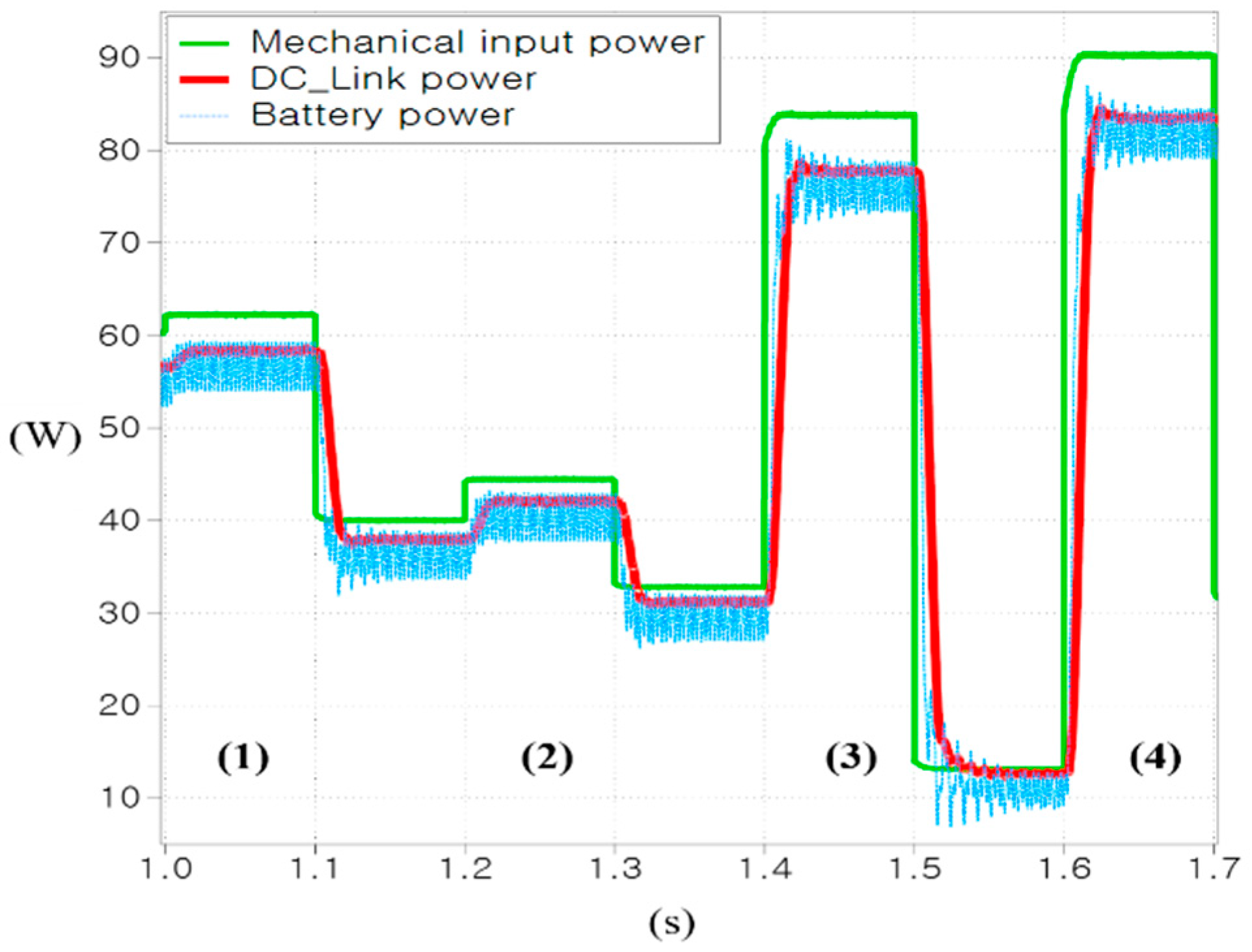



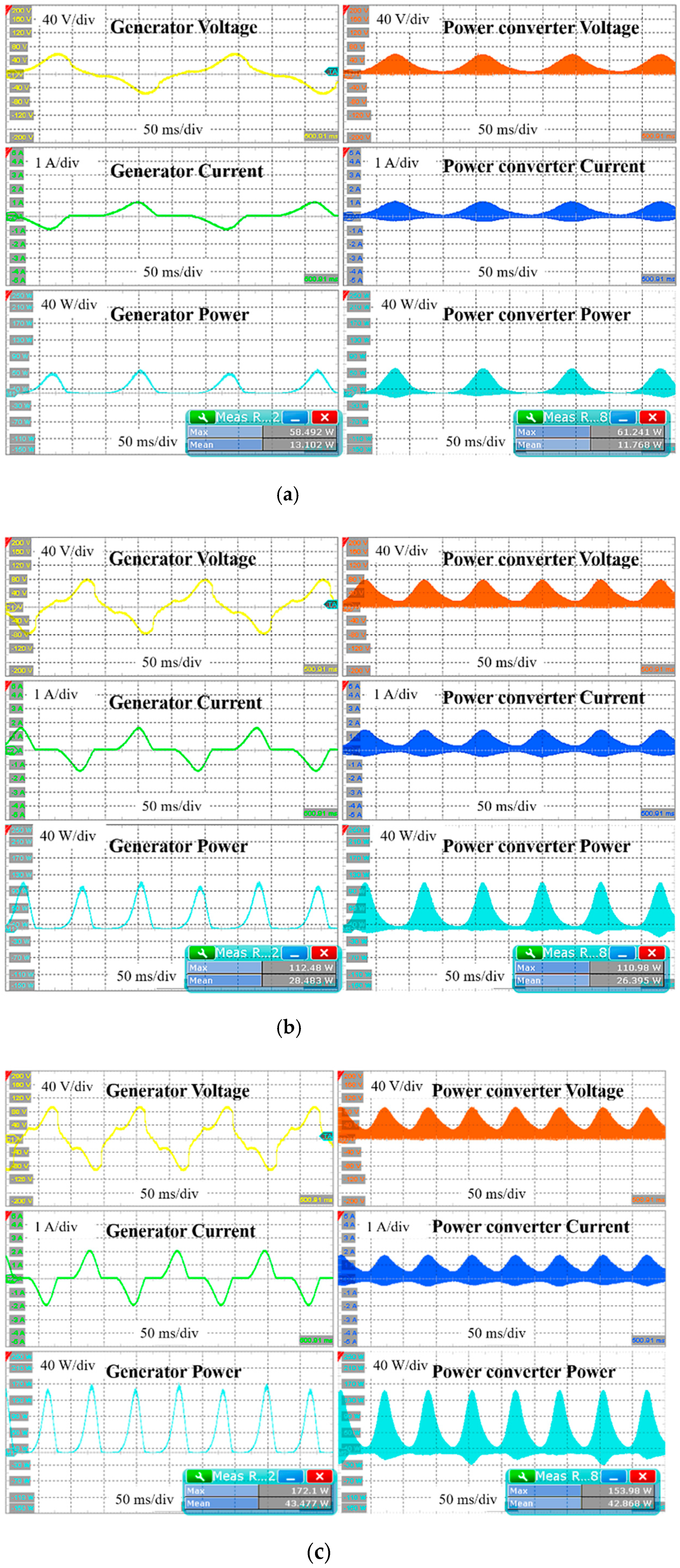
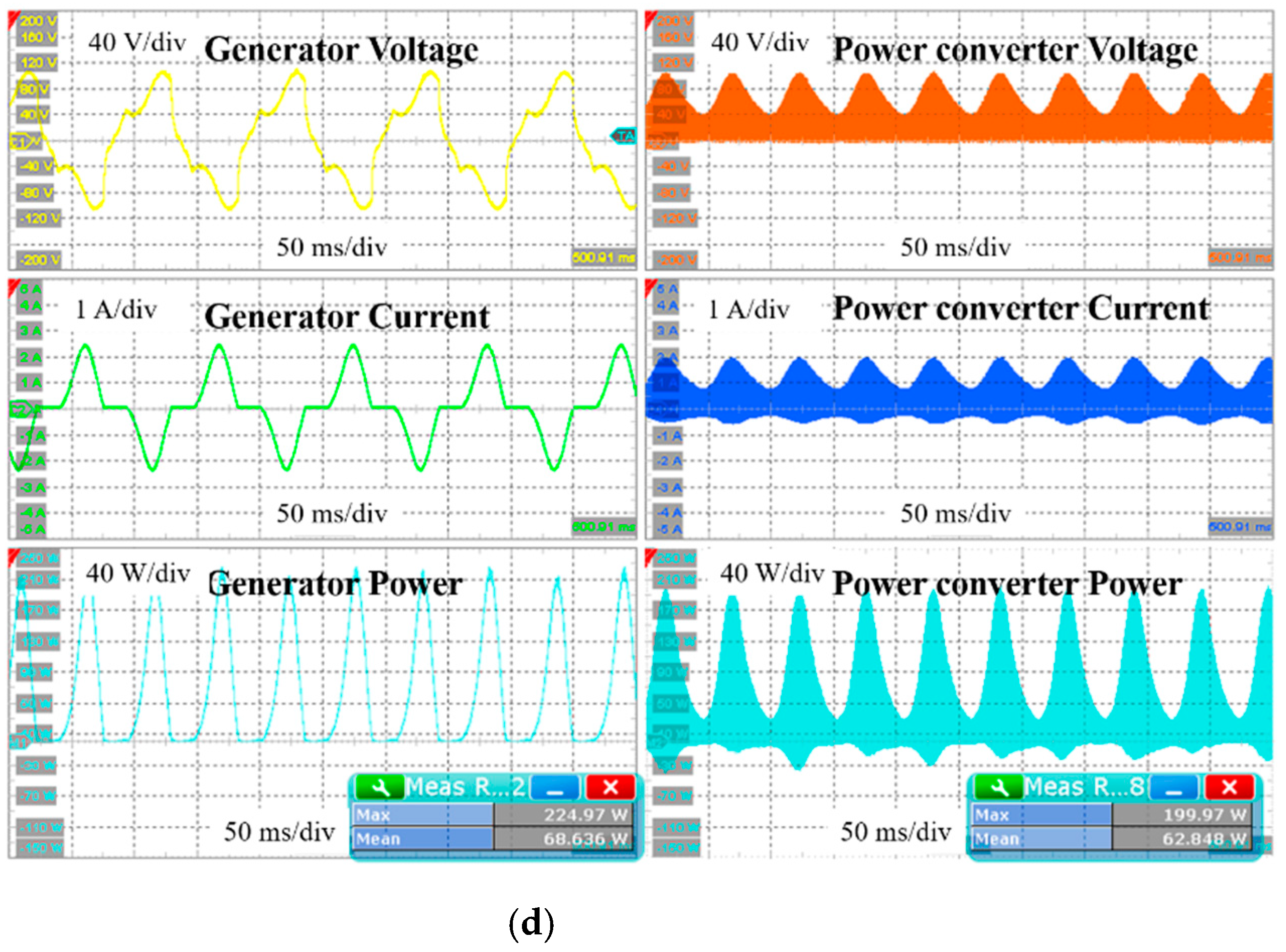
| Parameter | Value |
|---|---|
| DC link power | 100 W |
| Operation frequency of generator | 10 Hz |
| Nominal DC link voltage | 100 V |
| Voltage ripple on DC link | 5 V |
| Input voltage of buck converter vin | 100 V |
| Output voltage of buck converter vout | 48 V |
| Switching frequency fsw | 40 kHz |
| Inductor current ripple ratio LIR | 0.3 |
| Output max overshoot voltage vov, | 1 V |
| Inductor max current IOUT,max | 4 A |
| Load resistance R | 56 |
| Inductor peak current | 4.62 A |
| DC link capacitance | 501 μF |
| Buck converter inductance | 520 μH |
| Buck converter capacitance | 114 μF |
| Section | Mechanical Power | Rectifier Power | Battery Power | ||
|---|---|---|---|---|---|
| (1) | 59.6 W | 55.5 W | 93.1% | 54 W | 90.6% |
| (2) | 42.6 W | 39.7 W | 93.2% | 38.3 W | 89.9% |
| (3) | 80.3 W | 73.9 W | 92% | 72.7 W | 90.5% |
| (4) | 86.6 W | 79.8 W | 92.1% | 78.2 W | 90.3% |
| Vibration Speed | Average Machine Power | Average Converter Power | |
|---|---|---|---|
| 0.1 m/s | 13.1 W | 11.8 W | 89.8% |
| 0.15 m/s | 28.5 W | 26.4 W | 92.7% |
| 0.2 m/s | 43.5 W | 42.9 W | 93.2% |
| 0.25 m/s | 68.6 W | 62.8 W | 91.6% |
Publisher’s Note: MDPI stays neutral with regard to jurisdictional claims in published maps and institutional affiliations. |
© 2021 by the authors. Licensee MDPI, Basel, Switzerland. This article is an open access article distributed under the terms and conditions of the Creative Commons Attribution (CC BY) license (https://creativecommons.org/licenses/by/4.0/).
Share and Cite
Lee, J.; Chun, Y.; Kim, J.; Park, B. An Energy-Harvesting System Using MPPT at Shock Absorber for Electric Vehicles. Energies 2021, 14, 2552. https://doi.org/10.3390/en14092552
Lee J, Chun Y, Kim J, Park B. An Energy-Harvesting System Using MPPT at Shock Absorber for Electric Vehicles. Energies. 2021; 14(9):2552. https://doi.org/10.3390/en14092552
Chicago/Turabian StyleLee, Jinkyu, Yondo Chun, Jiwon Kim, and Byounggun Park. 2021. "An Energy-Harvesting System Using MPPT at Shock Absorber for Electric Vehicles" Energies 14, no. 9: 2552. https://doi.org/10.3390/en14092552
APA StyleLee, J., Chun, Y., Kim, J., & Park, B. (2021). An Energy-Harvesting System Using MPPT at Shock Absorber for Electric Vehicles. Energies, 14(9), 2552. https://doi.org/10.3390/en14092552








